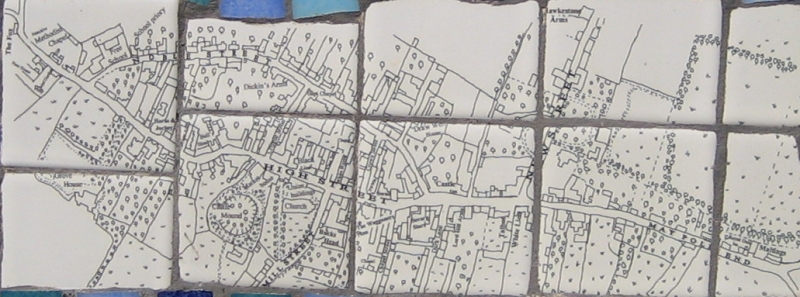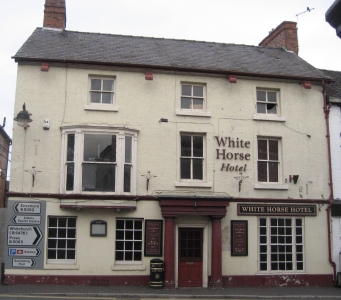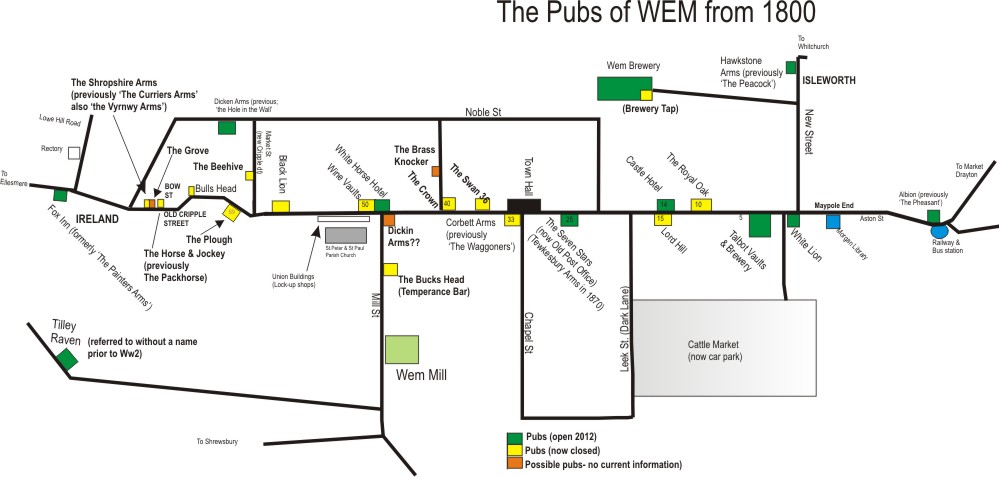The Inns of Wem
A former brewery town once boasting over 30 inns and taverns, Wem now has 6 pubs and imports all its beer from other brewing sites. The last brewery (Hanbys) closed in about 2010.  A tile map of the pubs in 1830 produced by Jenny Foord, potter of Wem and installed in Drawwell Lane as part of a pub tour Outlying pubsThere are 3 pubs in the town's suburbs, all by the main roads. The newest, the Albion, was built sometime after the railway arrived in 1860. To the north is the Hawkstone Arms on the Whitchurch Road, and to the west, The Fox at the 'Ellesmere Gate' in an area once known as Ireland.The north side of the High StreetFrom the east, the first inn was the Royal Oak (last recorded commercial directory entry in 1870). The Castle came next, which served both as a cattle market and as a coaching inn. Prior to the railways, it was one of the town pick-up points for the Shrewsbury to Manchester coach. There was a pub on either side of the entrance to Crown Street. the Swan (recorded in 1830 but not later) is now Princes electrical shop and the Crown (1970) is a hairdressers. The White Horse Hotel, once a notable coaching inn, closed in the early 2000's. Its off-licence shop, the Wine Vaults, closed in the late 20th century. At No 60 was the Black Lion which was still there in 1953, but is now a computer dealers. Beyond the castle mound were a row of pubs. The Bulls Head (up to 1890) is now part of Maunds Garage. The Horse and Jockey (also known briefly as the Packhorse) disappeared in 1995. One family ran it for nearly 50 years in the late 19th-early 20th century. It is believed that the house next door was the Grove but I have found no evidence of its listing after 1800. At No 90 was the Curriers Arms which closed in the late 19th century.
The south side of the High StreetBefore the coming of the railways, the road between what is now the station and the White Horse was known as 'Maypole End' and had sparse housing. Number 1 High Street was the White Horse, which was a coaching inn. Two doors up was the Talbot, a half-timbered building with its own brewery and stabling, and which was demolished in the 1960s to make way for a supermarket (now closed!) The Lord Hill at No 15 was home to Frederick Ratcliff, who also used the premises for his butchery business. This survived until around the Second World War. The Corbet Arms (No33) survived until the 1950s. On the south side of the castle mound corner was the Plough - gone by 1860)
The Temperence BarIn Mill Street (once known as Church Street) was the Buck's Head, a Temperence Bar. Such institutions served only non-alcohlic drinks and were very popular in parts of Lancashire, where there was a high percentage of teetotal Methodists. The oldest surviving one (2012) is Fitzpatricks in Rawtenstall, which serves cordials like Sarsaparilla, Blood Tonic and Dandelion & Burdock. In Wem it appears to have survived into the 1930s, and the Roebuck logo is still on the house wall.
There are many stories of of life in Wem when there were many pubs.For example, Sgt. Fletcher was the local policeman based at the station then in Chapel Street. He remembers that he was well known and well respected in the district. Jack can recall at least fifteen pubs in Wem and Sgt Fletcher had his work cut out dealing with the many drunkards that inhabited Wem in those days. Local resident Jack Phillips recalled seeing Sgt. Fletcher pulling a hand cart that drunkards would be thrown on and then wheeled to the police cells to sleep it off for the night. Saturday nights would have been very busy with people coming into Wem looking to spend their weekly wages. The High Street came alive on Saturday nights, with many shops staying open as late as ten, recalls Jack. The many pubs would have done a good trade too, making a policeman's job twice as hard. A lot of the inebriates would sleep it off in the church yard said Jack and as lads they heard many stories of those drunks sleeping under the raised grave stones. Twentieth century Pubs - who survived?
| ||||||||||||||||||||||||||||||||||||||||||||||||||||||||||||||||||||||||||||||||||||||||||||||||||||||||||


